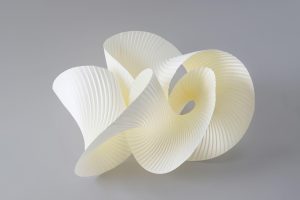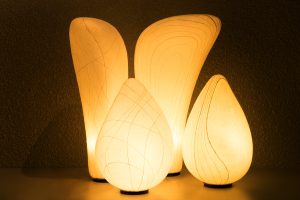
The work of nine Japanese contemporary paper artists (seven women and two men) is currently on display at the Morikami Museum and Japanese Gardens in an exhibit titled Washi Transformed: New Expressions in Japanese Paper, running through April 2.
A traveling exhibit curated by Los Angeles-based historian of Japanese art Meher McArthur, it features more than 30 highly textured two-dimensional works, expressive sculptures and dramatic installations that explore this traditional Japanese art.
“These nine contemporary Japanese artists are revisiting their nation’s traditional material and elevating it into a medium for expressive and often spectacular works of art,” says McArthur.
“The breathtaking creativity of these artistic visionaries deepens our understanding of how the past informs the present, and how it can build lasting cultural bridges out of something as seemingly simple and ephemeral as paper,” she says.
The nine artists, who were all born in Japan, with the exception of Yuko Kimura, who was born in California, include Hina Aoyama, Eriko Horiki, Kyoko Ibe, Yoshio Ikezaki, Kakuko Ishii, Yuko Nishimura, Takaaki Tanaka and Ayomi Yoshida.

Ikezaki, one of the two men (the other is Tanaka) earned his B.A. and an M.F.A. from Florida State University and currently divides his time between the U.S. and Japan, where he studied traditional Japanese paper making for six years with master papermakers Shigemi and Shigeyuki Matsuo.
Ikezaki makes his own washi paper and then uses the paper and sumi ink to create paintings and sculptures, into which he infuses his ki, or, energy, giving his works a spiritual quality, evident in his piece at the Morikami titled The Earth Breathes, made from handmade mulberry paper and sumi ink.
Some of the artists come from a sculptural and architectural background, such as Horiki, Tanaka and Nishimura and others such as Aoyama are more focused on words, poetry and literature.
Now living in France, Aoyama has devoted herself to creating super-fine, lace-like cuttings that express concepts and imagery from many different cultural traditions. Working with traditional origami paper, Aoyama cuts out minute details using very fine scissors and employs a meditative approach to forming her designs. Her subjects are drawn from sources as diverse as nature, including intricate flowers and butterflies, to the philosophy of Voltaire and the poetry of Baudelaire.
Nishimura graduated from the architectural design program at Nihon University in Japan and her love of architecture and form is evident in her paper work titled Continuous Form, a white, sculptural abstract design with meticulous pleats and folds, resembling a 1960s-era Pop art light fixture.

Also sculptural and light-like are Horiki’s Washi Light Object, fabricated from washi paper, resin mold and steel, creating an arrangement of four paper lights. Besides being a skilled paper maker, Horiki incorporates traditional washi paper into modern interior spaces.
Along with a team of paper artisans and artists, she creates large-scale sheets of textured paper that form the walls, room dividers, ceilings, windows and lamps of restaurants, hotel lobbies and public spaces throughout Japan.
On another note, fiber artist Ishii’s Japanese Paper Strings creates a whimsical paper sculpture with decorative Japanese paper cords called “mizuhiki,” sometimes used in ceremonial gift-giving. Resembling a vase, the cords hold red enoki mushroom-shaped fibers bursting out of the vase like so many red flowers.

California-born Kimura, whose 2020 etching and onkōzo handmade paper and kōzobark fiber, lace and thread piece titled Little Waves, is part of this show has worked with printmaking, etching, aquatint and dyeing with indigo on pleated paper.
Typically, she collages together hand-made washi paper with old, worm-eaten mushikui pages from Japanese books and worn fragments of cloth obtained in Japan from her grandmother, from whom she learned not to waste, exploring themes such as the passage of time, decay and renewal.
“For thousands of years in Japan, washi paper has been used not only for literature, painting, and printing, but also to create architectural elements (such as sliding shoji screens and lamps), sculptures, and even clothing,” says Carla Stansifer, curator of Japanese art at the Morikami Museum and Japanese Gardens.
“Now these contemporary artists are finding new and innovative ways to work with a very traditional material and I hope visitors will come away with an appreciation for the versatility of this all-natural material,” she says.
Washi Transformed runs through April 2 at the Morikami Museum and Japanese Gardens, 4000 Morikami Park Road, Delray Beach. The museum is open from 10 am to 5 pm Tuesday through Sunday. Admission is $15; seniors, $13; children, $9. Call 495-0233 or visit morikami.org. For more information, call (561) 495-0233 or visit morikami.org.